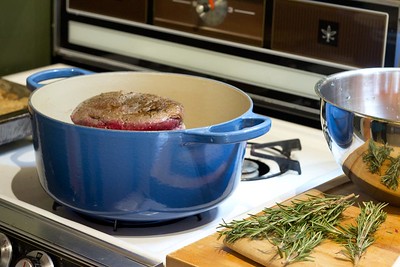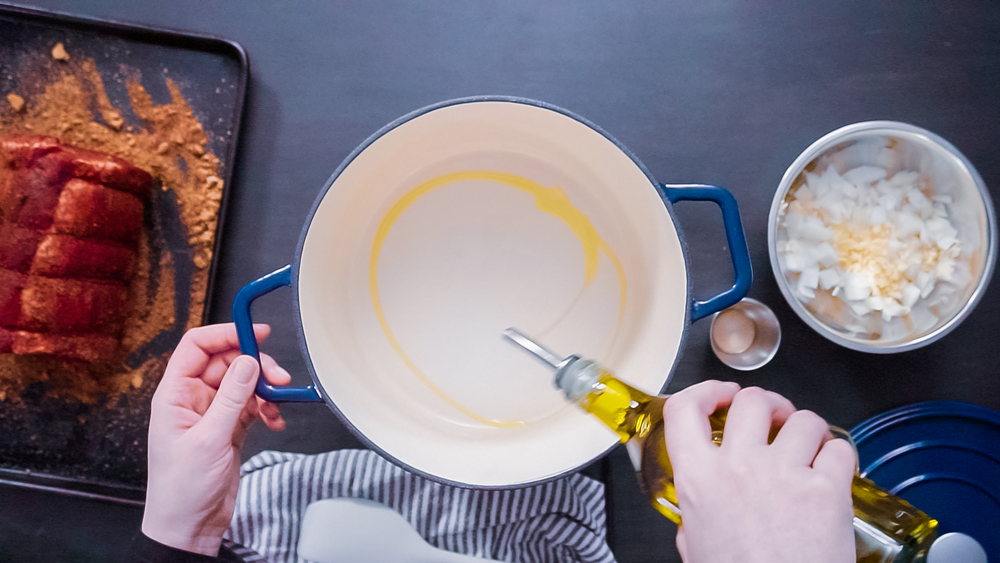Are you wondering how to season a Dutch oven? Like many traditional cooking utensils, a Dutch oven made with cast iron will often last longer if you know how to season it correctly. Cast iron cookware requires regular seasoning to maintain a non-stick performance and good durability. However, many people fail to prepare their Dutch ovens correctly.
If this is your first time using a Dutch oven at home, and you’ve never had to season a cast iron skillet in the past, you’re in the right place. Here, we will show you how to get the most out of your cast iron with vegetable, flax, soybean, or olive oil.
Why Is Dutch Oven Seasoning Important?
The seasoning process for a cast iron or enamel Dutch oven ensures you don’t have to use aluminium foil every time you want to access your Dutch oven without harming it. If you’ve ever used cast iron cooking tools before, you may know they’re excellent for even, effective cooking, but they’re not always prepared to hold up against acidic foods and regular use.
The factory seasoning or enamel coating included with your Dutch oven generally isn’t good enough on its own to protect your device long-term. So when cast iron and enamel cookware is placed on the shelf at the store, it usually features either:
- A simple protective coating helps defend against rust building up on the cast iron before opening the box. However, this initial seasoning will not protect against the high heat of cooking food in your Dutch oven.
- It is a type of cookware with a simple non-stick surface to provide protection, similar to cooking oil when using your iron cookware. However, this coating may not be the best if you use your cooking utensil regularly and wash it with harsh products like steel wool.
Some of the protective coating options designed to protect your utensils every time you cook aren’t designed to taste great – they protect against rust spots. This could mean you get an odd taste with the first meal you make at high heat. This is why some prefer it’s best to remove the existing coating with scouring pads and apply your seasoning to improve the taste of your favourite foods.
How Do You Season a New Dutch Oven?
The good news for anyone who wants to improve the quality of their cast iron products or Dutch oven is that you can easily season your Dutch oven without prior experience. When seasoning a Dutch oven, you need to rub oil, such as avocado oil, soybean oil, flaxseed oil, or something similar, onto the bottom of your cast iron to create a non-stick surface.
The manufacturers of non-stick utensils will surely provide proper cooking procedures to ensure you’re aware of ways of protecting your utensils on the hob or the bottom rack of your oven. Notably, you’ll only need to season, and re-season a Dutch oven made with cast iron, as enamel doesn’t need the same level of protection.
It’s also worth inspecting the state of your Dutch oven inside the device since some manufacturers add a waxy substance similar to a cookie sheet, which can harm the taste of your food when cooked at a high temperature.
Before You Start
You can easily remove the wax from your pre-seasoned Dutch oven by placing an aluminium foil-covered sheet at the bottom of your oven and placing the Dutch oven upside down on the upper top rack. Bake at around 200 degrees Celsius for an hour and wait for the wax and oil to melt off. Once all the oil and wax are gone, turn off the heat. Then wait for the product to cool down.
How to Season a Dutch Oven: A Step-By-Step Guide
Step 1: Wash and Dry
Once you’ve removed the wax from the top of your cast-iron Dutch oven, wash it with soapy water and dry it completely. If your Dutch oven has been baking for one hour in the larger oven, you’ll need to wait for it to cool down before applying the new seasoning.
Step 2: Scrub It
Line a baking sheet with foil and place it on the bottom rack of your oven and preheat the oven to 200 degrees Celsius. The heat needs to be high for re-seasoning. Scrub your Dutch oven carefully with a stiff brush and thoroughly dry it with paper towels or a microfiber towel.
Step 3: Apply an Oil of Your Choice
Using a paper towel, apply a layer of flax oil, vegetable oil, soybean oil, peanut oil, canola oil, coconut oil, or vegetable shortening to the oven and lid.
Cover every part of the Dutch oven, and make sure you get into every corner. If you have excess oil, you can pour the extra olive oil or vegetable oil out or place it into your cast iron skillet for seasoning cast iron again later.
Step 4: Cover and Bake
Place the lid of the Dutch oven upside down on the top rack of the oven and bake for an hour. Similar to seasoning a cast-iron skillet, you might see smoke rising from the brand new Dutch oven during the seasoning process.
Step 5: Leave It to Cool
After an hour, switch off the oven and leave your cast iron seasoning to cool down for about thirty minutes. Then, remove the Dutch oven, and it should be ready to use.
What Type of Oil Do You Use to Season a Dutch Oven?
The great thing about seasoning a Dutch oven, or any cast iron, is that you have plenty of options once you’ve removed the pre-seasoned coating. You can apply plenty of oils with a paper towel to create your protective layer. Of course, the right option will depend on what heat you usually cook at, as some oils have a higher burning point.
You can also consider the kind of flavours you like when you season cast iron. Dutch ovens can bake a wide range of foods, so choosing a versatile oil when seasoning this cast iron is good.
Remember, your cast iron Dutch oven is likely to need seasoning. The frequency with which you need to season a cast-iron Dutch oven will depend heavily on how much you will use it. So before seasoning cast iron for a second time, check the Dutch oven for any signs of rust or damage. If rust has begun to set in, you will need to strip the coating and start again.
How Often Should I Season Cast Iron?
The more you wash your cast iron with hot soapy water or cover it in too much oil when you’re cooking, the more likely you’ll need to re-season it in the future. But if you use your Dutch oven properly and follow the manufacturer’s instructions, the season should last a while.
Another thing to note is that you’ll need to re-season your Dutch oven early if you haven’t used the best oil for your cooking the first time or prefer to cook highly acidic foods, like tomatoes.
Warning Signs
Watch out for signs there isn’t much oil left when cooking, such as:
• Food sticking to your Dutch oven’s surface
• The surface of the iron is dull and isn’t shiny or smooth
• You’re noticing scrapes and stains on your cast iron
Do I Need to Season My Enamelled Dutch Oven?

Essentially, it’s worth noting that there are several different kinds of Dutch ovens today. You only need to season a Dutch oven if you’re using a cast iron product. On the other hand, you don’t need to season an enamelled cast iron product because the enamel on your iron is generally enough to provide a non-stick coating. Moreover, it doesn’t start to crack or peel away when washed with hot soapy water.
The best thing to protect your enamelled products is to make sure you don’t cook them at temperatures exceeding their burning point, besides cleaning them properly. You can often clean enamelled cast iron in the sink, but some may not be suitable for placing in the dishwasher, so read the instruction manual carefully.
What’s more, avoid using some random cleaning materials to clean your cast iron or enamel products because they might damage the surface. For instance, extremely harsh chemicals can strip some of the natural seasoning or non-stick substances from your cookware. Another thing to notice is that if you’re seasoning cast iron too regularly, you’re probably washing your products too vigorously.
Tips for Long-Term Longevity
• Try not to scrub your cast iron too aggressively
• Avoid any harsh cleaning products like steel wool
• Watch out for signs of damage to your cast iron and repair them as quickly as possible.
Seasoning Your Cast Iron Cookware
As cast iron products become more popular in every kitchen, from skillets to Dutch ovens, people get more comfortable seasoning their products at home. It doesn’t take too long to season cast iron cookware at home for effective use. As long as you follow the process mentioned above, it would help if you didn’t have to re-season for a while, provided you don’t ruin the cast iron with anything too harsh, like steel wool.
Please keep in mind to wash your Dutch oven and regularly cast iron products with hot soapy water between uses, and remember to keep a close eye on any signs of foods or aluminium foil sticking or dishes not cooking correctly. The more you look after your Dutch oven, the less likely you’ll need to re-season or replace the product.

